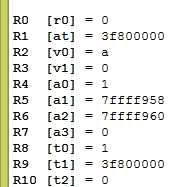Memory access is much slower than copying between registers.
## Move data between the coprocessor and the CPU
.text
.globl main
main:
li $t0,1 # $t0 <-- 1
# (move to the coprocessor)
mtc1 $t0,$f0 # $t0 --> $f0
li.s $f1,1.0 # $f1 <-- 1.0
# (move from the coprocessor)
mfc1 $t1,$f1 # $t1 <-- $f1
li $v0,10 # exit
syscall
Here is a program that moves bit patterns between floating point and general purpose registers. The program loads a general purpose register with a two's complement 1 and copies that pattern to a floating point register. Then it loads a floating point register with an IEEE 1.0 and moves that pattern to a general purpose register.
The bit pattern 00000001 is the two's complement representation of one.
It is now in registers $t0 and $f0.
Here is what the SPIM registers contain after running the program:
The bit pattern 3f800000 is the IEEE representation of 1.0.
That pattern is now in registers $f1 and $t1.
(It is also in register $at which is used in implementing the pseudoinstruction li.s).


Could floating point arithmetic be done with the
value in register $f0?
Inspect the contents for FP0 in the SPIM register display.